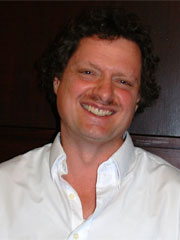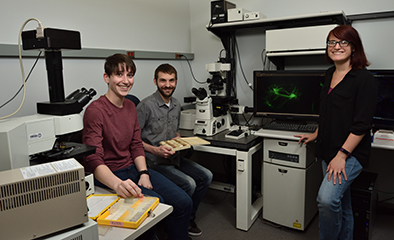CBMP Faculty
Sanford H. Leuba, Ph.D.

Department: Dept of Cell Biology
Email: leuba@pitt.edu
PubMed: Link
Dept / Lab Webpage: http://www.cbp.pitt.edu/faculty/leuba/index.html
CBMP groups: DNA Damage/Repair, Cell-Cycle Control and Gene Expression, Cancer
Research Interests
Molecular biologists have come to realize that chromatin structure and dynamics is of major importance in regulating transcription, replication, and repair. Our interests are to understand at the single nucleosome and single chromatin fiber level the interrelationship between biological processes using DNA as a template and the structure and dynamics of chromatin. To this end, we are applying several single-molecule approaches such as atomic force microscopy (AFM), magnetic tweezers, optical tweezers, and single-pair fluorescence resonance energy transfer (spFRET) to native or reconstituted chromatin fibers of different protein compositions. Single-molecule techniques provide the sensitivity to detect and to elucidate small, yet physiologically relevant, changes in chromatin structure and dynamics. For example, recently, we have been able to:
- detect conformational changes in fiber structure due to the presence of 24 methyl groups per nucleosome (AFM);
- investigate the role of histone variants in chromatin fiber structure (AFM);
- determine the piconewton forces to unravel individual nucleosomes in a fiber context (optical tweezers);
- follow in real time the assembly and disassembly of nucleosomes on a single DNA molecule (magnetic tweezers);
- demonstrate fast, long-range, reversible conformational fluctuations in nucleosomes between two states: fully folded (closed) with the DNA wrapped around the histone core, or open, with the DNA significantly unraveled from the histone octamer (spFRET).
- In collaboration with Saleem Khan (Microbiology and Molecular Genetics), we have used spFRET to demonstrate that PcrA DNA helicase displaces RecA from both ssDNA as well as dsDNA as a model for regulation of homologous recombination.
- In collaboration with Pedro Rodriguez-Collazo (Cell Biology and Physiology), we have developed a method to isolate in one-step histones containing their native post-translational modifications (Rodriguez-Collazo et al., 2009). This method has also been patented and licensed.
The kinds of experiments we perform and the expertise in our laboratory range from molecular biology/biochemistry to engineering and physics. We believe that our considerable knowledge and experience in the chromatin field, combined with our ever-increasing capabilities in using single-molecule approaches put us in a unique position to approach a number of unresolved structural issues and to seek the elusive link between chromatin structure and function.
